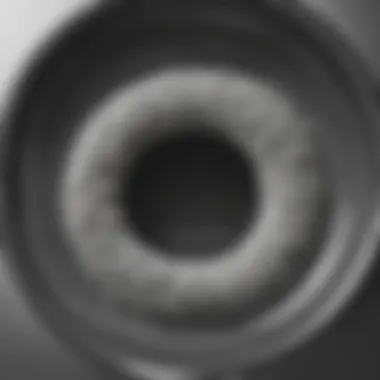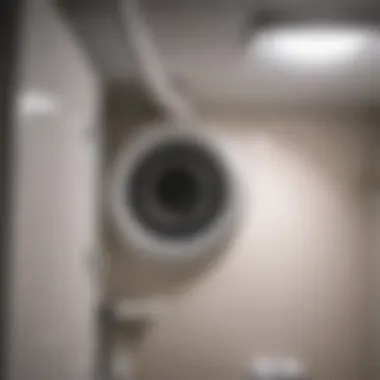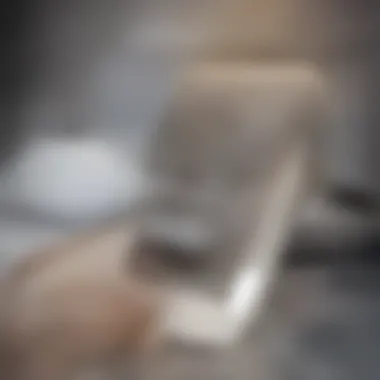Essential Troubleshooting Tips for Samsung Dryers


Intro
Having a reliable dryer is key to managing household chores efficiently. However, sometimes your Samsung dryer may develop issues that prevent it from effectively drying clothes. This can be frustrating, and understanding the causes can make a difference. In this guide, readers will find detailed insights on how to troubleshoot a Samsung dryer that won't dry clothes. By identifying the problems and applying the correct solutions, one can restore the drying performance of their appliance.
Key Points to Discuss
- Common technical problems that lead to inadequate drying.
- Regular maintenance tasks that can enhance dryer efficiency.
- User errors that often result in malfunctioning dryers.
- Diagnostic approaches for identifying issues.
- Practical solutions and preventative measures to avoid future problems.
Understanding these elements is crucial not only to resolve present issues but also to maintain optimal functioning in the long term.
Understanding Dryer Functionality
Understanding how a dryer works provides key insights into diagnosing issues like inadequate drying performance. Grasping the fundamental principles of dryer functionality lays a solid foundation for effectively troubleshooting your Samsung dryer. It also helps users to analyze symptoms and understand the intricacies that come into play during the drying process.
In this section, we will look closely at two crucial aspects that define dryer operation: the basic components of a dryer and the drying cycle. Knowing these elements enables users to identify common malfunctions and seek appropriate solutions.
Basic Components of a Dryer
A Samsung dryer consists of several integral components, each serving a specific purpose in the drying process.
- Drum: The large cylindrical container where clothes are placed for drying. It rotates to circulate air and tumble the garments.
- Heating Element: This component generates heat, essential for evaporating moisture from clothes. A faulty heating element is often a common cause of drying issues.
- Thermostat: It regulates the temperature within the dryer. If the thermostat is malfunctioning, it can lead to overheating or insufficient heat.
- Ventilation Duct: This pathway directs hot air out of the dryer. Blocked ducts can prevent air circulation, impairing drying efficiency.
- Moisture Sensors: These detect the moisture level in clothes. They help to optimize drying time and energy consumption.
Each of these components works in concert to ensure clothes are dried effectively. If one part fails, it can disrupt the entire process.
Drying Cycle Explained
The drying cycle is a sequence of events that a dryer undergoes to remove moisture. It can be broken into several phases:
- Heat Up: The dryer begins by raising the temperature inside the drum through the heating element. This phase lasts until the desired temperature is reached.
- Tumbling: After heating, the drum rotates, mixing the clothes and allowing hot air to penetrate fabrics. This movement is crucial as it ensures even drying.
- Moisture Evaporation: As the drum rotates, moisture from the clothes evaporates and gets carried away by the airflow.
- Cooling Down: Towards the end of the cycle, the dryer cools down to minimize wrinkling in the fabric. This phase is important for maintaining the integrity of the clothes.
Understanding the drying cycle helps identify where in the sequence a problem may occur. For instance, if the dryer is heating but clothes remain wet, the issue may lie within the moisture sensors or air circulation.
"A well-functioning dryer not only saves time but also energy, making it a crucial appliance in any household."
By becoming acquainted with these fundamental elements, users can better address issues related to drying performance. This comprehension is essential for the subsequent sections that delve into common reasons for dryers not functioning as expected.
Common Reasons a Samsung Dryer Will Not Dry Clothes
Understanding why a Samsung dryer is not drying effectively is crucial for both troubleshooting and maintenance. Identifying common issues can save time and prevent frustration. Furthermore, knowing these reasons allows users to take proactive steps in keeping their dryer in optimal condition, ensuring reliable performance.
Overloading the Dryer
Overloading is a frequent issue that can lead to ineffective drying. When a dryer is overloaded, clothes do not have enough space to tumble freely. This lack of movement prevents warm air from circulating properly around the load. The result is damp articles of clothing, which remain that way even after a full cycle. Users should strive to follow the manufacturer's guidelines regarding load size to optimize drying efficiency. Reducing load sizes can drastically improve drying results and extend the life of the dryer.
Blocked Ventilation Ducts
Blocked ventilation ducts present another significant reason for inadequate drying. Dryer vents can accumulate lint, debris, or even small objects over time. When airflow is blocked, the dryer struggles to expel moisture effectively. Not only does this make drying inefficient, but it also poses a fire hazard. Inspecting and cleaning the venting system regularly is essential. Users can perform this task themselves or seek professional help if necessary. Ensuring that the vent is clear can improve drying performance and safety.
Faulty Heating Element
The heating element is critical for converting electrical energy into heat. If this component malfunctions, the dryer won't produce the necessary heat to dry clothes. A faulty heating element may show signs like unusual noises or failure to heat altogether. Diagnosing this issue can be done by visually inspecting the element or testing it with a multimeter. In cases of failure, replacement is often the solution. Addressing a defective heating element quickly restores drying capacity.


Thermostat Malfunctions
Thermostats regulate temperature within the dryer. If a thermostat is faulty, it might prevent the dryer from reaching optimal heating levels. Symptoms include clothes coming out still wet or overheated. Inadequate temperatures can lead to prolonged drying times. To resolve thermostat issues, it's recommended to check its functionality using a multimeter. If they are found to be defective, replacement will restore normal operation, ensuring that clothes dry efficiently.
Moisture Sensors Issues
Modern Samsung dryers often contain moisture sensors that help detect the moisture level within the drum. If these sensors are dirty or malfunctioning, they may not function properly. This can result in the dryer stopping too early or not running long enough to fully dry clothes. Regular cleaning of these sensors is important. If they are found to be non-functional, replacement may be necessary to restore proper drying cycles.
Regular maintenance and understanding common issues can significantly improve the efficiency and safety of your Samsung dryer.
Diagnostic Steps for Troubleshooting
When a Samsung dryer fails to dry clothes, thorough diagnostic steps are crucial. These steps help identify the root cause of the problem, which can save time and effort. By systematically checking different aspects of the dryer, users can hone in on specific issues that may be hindering performance. This not only aids in faster repairs but also ensures that any solutions implemented will address the actual problems. Moreover, approaching troubleshooting logically helps prevent overlooking simple errors that could easily be resolved.
Initial Observations
Before diving into technical checks, it's important to start with initial observations. These observations allow you to note any irregularities in the dryer operation. Check whether the dryer is making unusual noises or if there is an unusual odor emanating from the unit. Pay attention to the dryer’s control panel for any error codes.
Sometimes, a reset can fix minor glitches. To reset the dryer, unplug it for about 5 minutes and then plug it back in. Observe if this resolves any of the issues.
Testing Temperature Settings
Temperature settings play a key role in the effectiveness of drying. It is necessary to verify that the selected settings correspond to the load type. For instance, heavier fabrics such as towels may require higher heat settings, while delicates need lower temperatures.
Using a thermometer, you can test the dryer temperature. Place a few wet items inside the dryer and run it for a typical cycle, then measure the temperature with an accurate thermometer. If the temperature does not match expected levels, adjusting the thermostat may be required.
Checking the Exhaust System
The exhaust system is vital for proper dryer operation. A blocked or poorly functioning exhaust can inhibit airflow, leading to insufficient drying and potential overheating hazards. Start by examining the lint trap. If clogged, clean it thoroughly. Then, inspect the vent duct. Ensure there are no bends or obstructions that block airflow.
You can also conduct a flow test. Run the dryer with a clean filter and duct, and observe how air flows out of the vent outside. A weak airflow indicates a problem within the duct system. Addressing these concerns can significantly improve drying efficiency.
Practical Solutions to Common Problems
When dealing with a Samsung dryer that will not dry clothes properly, finding effective solutions to common problems is crucial. It allows users to understand the factors contributing to inefficient drying performance. By addressing these specific issues, users can restore their dryer’s functionality and save on energy costs. It is vital to approach these solutions systematically. Each solution is designed to tackle a particular challenge, enhancing the overall efficiency of the dryer. Let’s examine practical interventions in detail.
Reducing Load Size
One of the simplest yet most effective solutions is to reduce the load size when using the dryer. Overloading can hinder the tumbling motion necessary for proper heat circulation, making it harder for clothes to dry effectively. A well-balanced load allows for better airflow and more efficient heat distribution. If your dryer is packed too tightly, it may cause excessive strain on the motor and potentially lead to increased wear over time.
A good practice is to separate heavier items like towels from lighter garments. This separation not only promotes more even drying but can also help prevent items from becoming tangled or twisted, which often inhibits air movement. Furthermore, running smaller loads can reduce drying time, ultimately increasing the lifespan of your dryer. Common guidelines suggest that each load should not exceed three-quarters of the dryer’s capacity.
Cleaning Ventilation Ducts
Blocked ventilation ducts are a common cause of an underperforming dryer. Lint and debris can accumulate in the ductwork, restricting airflow, which in turn affects the dryer’s ability to expel moisture. Regularly cleaning these ducts is essential for safe and optimal operation.
Homeowners should aim to clean the ducts at least once a year. To do this, disconnect the dryer from the power supply and then remove the ductwork. Use a vacuum cleaner with a hose attachment to remove any lint build-up. If the duct is excessively clogged, consider using a duct cleaning kit or hiring a professional service.
Key steps for cleaning the ducts:
- Disconnect dryer from power.
- Remove the vent duct from the back of the dryer.
- Vacuum lint and debris with a specialized nozzle.
- Reattach the duct and ensure it is fitted snugly.
- Run the dryer for a few minutes to check for any obstructions.
By ensuring that ventilation ducts are clean, users can significantly improve drying performance and reduce the risk of fire hazards.


Replacing the Heating Element
If your Samsung dryer still fails to dry clothes after addressing load size and ventilation issues, the heating element may be faulty. This component generates the necessary heat for the drying process. A malfunction can result in insufficient or no heat at all, leading to damp laundry.
To assess the heating element, first disconnect the power supply to the dryer. Next, remove the back panel to access the heating element. Using a multimeter, test the element for continuity. If there is no continuity, it indicates the component is defective and needs replacing.
Steps to replace a heating element:
- Disconnect dryer from power.
- Remove the back panel and locate the heating element.
- Test with a multimeter and remove if necessary.
- Install the new heating element by connecting it in the same manner as the old one.
- Reattach the back panel and restore power.
Replacing a faulty heating element can restore the dryer’s function and efficiency.
Adjusting Sensor Settings
Modern Samsung dryers incorporate moisture sensors that monitor the dampness of the clothes. If these sensors are miscalibrated or malfunctioning, it may lead to incorrect drying cycles. This issue often manifests as clothes remaining wet or the dryer running excessively.
To address sensor issues, check if the sensors are clean. Built-up lint or residue can affect their accuracy. Gently cleaning the sensor with a soft cloth can sometimes resolve these problems. If the issue persists, consider recalibrating the settings following the manufacturer's manual or seeking a professional technician’s help.
Points to consider for sensor maintenance:
- Regularly inspect and clean sensors.
- Understand the dryer settings to enhance performance.
- Seek professional help for recalibration if necessary.
In summary, practical solutions to common dryer problems—like reducing load sizes, cleaning ventilation ducts, replacing heating elements, and adjusting sensor settings—can lead to improved functionality and extended lifespan of your Samsung dryer. Implementing these steps can reduce frustration and ensure optimal performance.
When to Seek Professional Help
Ensuring your Samsung dryer functions optimally is essential, but there are times when the issue goes beyond simple fixes. At this point, knowing when to call a professional can save time and prevent further damage. Recognizing the signs and understanding warranty options are crucial.
Signs of a Major Breakdown
Several indicators suggest that your dryer may be experiencing a serious breakdown. First, if your dryer emits strange noises, such as banging or grinding, it could indicate that internal components are failing. This is often a sign of a malfunctioning motor or drum support.
Another critical sign is the presence of burning smells. A burning odor suggests overheating, which might result from faulty wiring or an obstruction in the dryer. Ignoring this could lead to severe safety hazards.
Additionally, if the dryer runs without producing heat even after checking your settings, it might suggest significant issues with the heating element or thermostats. Over time, non-drying clothes, even after repeated cycles, are a clear indication that professional intervention is needed. Do not dismiss these signs, as they can escalate into more costly repairs or replacements.
Understanding Warranty Options
When your dryer faces problems, reviewing warranty options is beneficial. Samsung dryers typically come with a one-year limited warranty that covers manufacturing defects. This might include issues caused by faulty parts or assembly errors. Knowing your warranty status can lead to considerable savings.
To understand your warranty options, locate your proof of purchase. This ensures the warranty is still valid. Contact Samsung's customer service or visit their website for detailed information about what is covered and the claims process.
"Warranties can significantly minimize repair costs, but they must be acted upon swiftly to avoid lapsing."
If your dryer is out of warranty, consider the cost of potential repairs against the price of a new unit. Many repair services offer diagnostic fees that might be waived if you proceed with repairs through them.
In summary, recognizing the symptoms of a major breakdown and being aware of warranty options play a key role in maintaining dryer efficiency. Calling a professional could avoid unnecessary complications and ultimately provide peace of mind.
Preventative Maintenance for Efficiency
Preventative maintenance is crucial for ensuring the optimal performance of your Samsung dryer. The general idea is simple: performing routine tasks can help avoid major repairs and ensure that your machine operates efficiently. This means fewer drying cycles, lower energy usage, and longer life for your appliance.


A dryer that runs effectively not only reduces the frequency of issues but also saves you money in the long run. Regular cleaning and maintenance can enhance energy efficiency, contributing to lower electricity bills over time. Not only is it beneficial for your finances, but also for the environment, as an efficient dryer uses less energy.
Another consideration in preventative maintenance is the safety of your household. Lint build-up can lead to overheating and is a leading cause of dryer fires. Taking time to maintain your dryer means you are safeguarding your home as well.
Routine Cleaning Tips
One of the simplest but most effective forms of maintenance is regular cleaning. Cleaning the lint filter is essential and should be done after each use to ensure maximum airflow. Furthermore, you should also clean the venting system at least once a year.
- Remove lint from the dryer lint trap after every load. This ensures proper airflow and helps the dryer operate more effectively.
- Inspect and clean the exhaust duct regularly to prevent lint from accumulating.
- Check the interior of the dryer for any built-up lint or debris periodically. A vacuum can help remove any visible lint.
These small actions, when done consistently, can greatly contribute to efficiency.
Regular Inspections
A thorough inspection of your dryer can uncover potential issues before they escalate. Schedule a professional inspection annually to check crucial components.
- Inspect the heating element for wear-and-tear to avoid malfunctions during drying cycles.
- Check hoses and connections to ensure there are no leaks or blockages that could hinder performance.
- Verify the moisture sensors are clean to maintain their effectiveness.
By making inspections a routine, you uphold the health of your appliance and contribute to its efficiency.
Setting Dryer Cycles Appropriately
Understanding how to set your dryer cycles can have a profound impact on efficiency. Every load type requires a different approach for optimal drying.
- Use the appropriate cycle according to fabric type. For example, delicate fabrics require cooler settings.
- Select shorter drying cycles for lighter loads which can help improve efficiency and reduce wear.
- Consider using moisture sensor settings if your Samsung dryer has this feature. They adjust the drying time based on moisture levels in the clothes.
Setting the dryer cycles properly not only helps slices utility costs but also aids in the longevity of your garments.
Preventative maintenance is not just a choice, but a necessity for prolonged functionality of your Samsung dryer.
Assessing Energy Efficiency
Assessing energy efficiency is a key aspect often overlooked when troubleshooting a Samsung dryer that does not dry clothes. Understanding this concept not only aids in resolving the immediate drying issues but also contributes to long-term savings and environmental sustainability. Energy efficiency influences how a dryer operates, its power consumption, and its overall performance. With the rising costs of utilities and increasing awareness of ecological footprints, evaluating energy efficiency becomes essential for users.
Understanding Energy Ratings
Energy ratings are an important component in assessing the efficiency of household appliances, including dryers. These ratings provide insight into the energy consumption levels, helping users make informed decisions. Samsung dryers typically come with energy labels that often include information about their annual energy use, measured in kilowatt-hours (kWh). A lower kWh figure usually indicates a more efficient dryer.
When purchasing or using a dryer, pay attention to its energy star certification. This certification signifies that the appliance meets strict energy efficiency guidelines set by the U.S. Environmental Protection Agency. Choosing a dryer with this label can lead to substantial savings on electricity bills over time, as these appliances use less power while performing optimally.
Impact of Inefficient Drying
Inefficient drying can have numerous negative impacts, both financially and practically. When a dryer operates inefficiently, it often leads to increased energy consumption, which results in higher utility bills. Moreover, prolonged drying cycles may cause wear and tear on the machine components, leading to a shorter appliance lifespan.
Additionally, inefficient dryers can make laundry days more tedious. Clothes remain damp after cycles, requiring more time and energy for further drying or forcing users to resort to alternative drying methods like air drying. This adds to the burden of maintaining a functional laundry routine.
The following are some consequences of using an inefficient dryer:
- Higher monthly energy costs.
- Increased frequency of repairs due to overstressed components.
- Longer waiting times for laundry to dry.
- Potential damage to clothing from excessive heat exposure over time.
Epilogue
Recap of Key Points
- Common Issues: Overloading the dryer and blocked ducts frequently impact performance negatively. Recognizing these issues early can prevent further complications.
- Diagnostic Steps: Observing initial symptoms, checking temperature settings, and inspecting the exhaust system are critical first steps.
- Practical Solutions: Reducing load sizes, cleaning the ducts, and possibly replacing parts like the heating element are practical remedies.
- Professional Help: Identifying when to call a technician or understand warranty options is essential for efficient resolution.
- Energy Efficiency: Understanding energy ratings and the impact of inefficient drying can lead to cost savings and better appliance usage.
Encouragement for Further Research
While the troubleshooting methods discussed are actionable, readers are encouraged to delve deeper into maintenance practices and technological upgrades for their Samsung dryer. Consulting resources such as Wikipedia, Britannica, and forums on Reddit can provide additional insights. Understanding the appliance’s technology, considering energy-efficient models, and familiarizing oneself with common repairs can vastly improve drying efficiency. This continued exploration will enhance practical skills and ensure optimal appliance performance.







